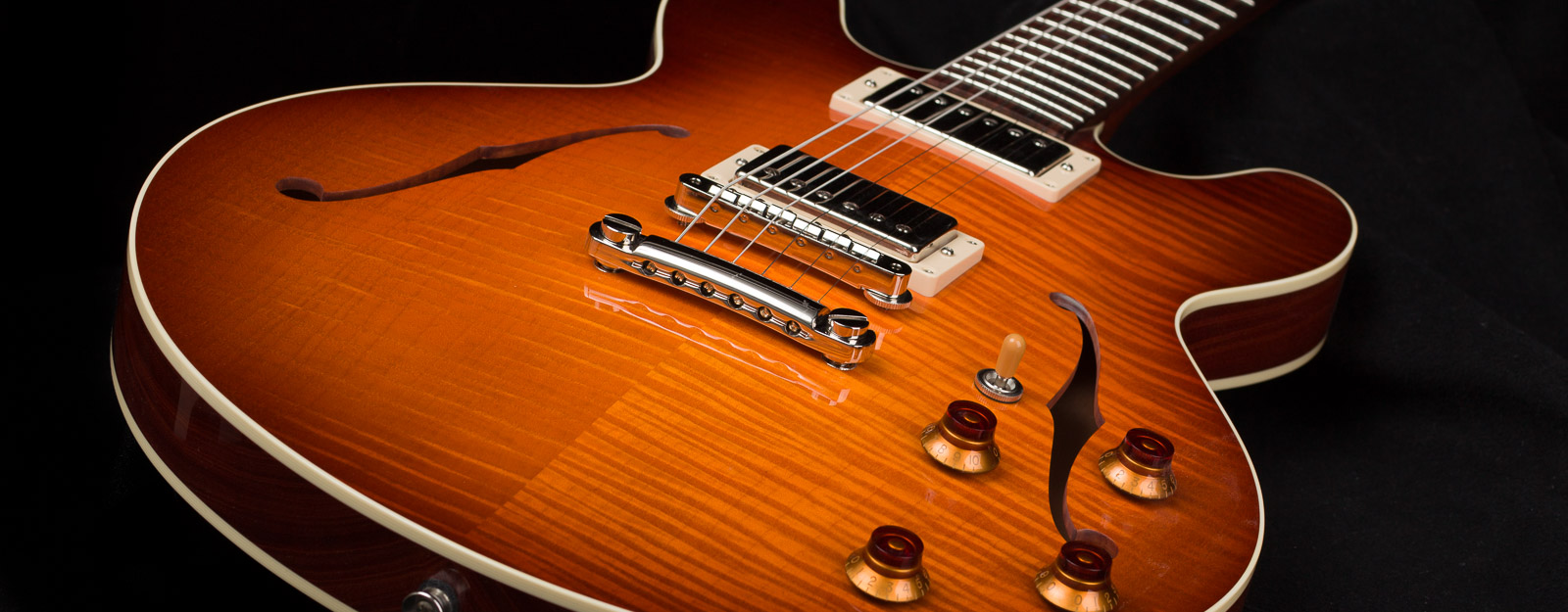FAQ Topics

Electric Guitars
Custom Orders
Setup
Pickups & Components
Serial Numbers & Dating
Warranty & Registration
Parts & Repair
Custom Orders
How long does it take to place a special order?
The lead time for new orders can vary depending on the model and the existing backlog of orders. Most new orders can be built within 3-4 months. Your dealer will be able to provide you with a price quote and estimated delivery timeframe. All custom orders must be placed through an authorized Collings dealer.
Setup
What type of strings do you use?
Our electric models are strung with D'Addario NYXL1149 strings (.011", .014", .018", .028", .038", .049").
Tone
Is there a tonal difference between the I-35 and SoCo models?
We find that there to be only subtle tonal differences between the SoCo Deluxe and I-35 Deluxe models. Both guitars have semi-hollow body construction and use the same low-wind Imperial humbuckers from Jason Lollar. The biggest difference is that the single-cutaway design of the SoCo Deluxe adds mass to the body and also increases the contact area of the neck joint. This seems to give the SoCo Deluxe a slightly more focused sound with greater low end definition (slightly less airiness/overtones compared to the I-35 Deluxe). Again, this is a very subtle tonal difference. Wood selection (flame vs. quilt) and fingerboard material are other factors that play into the overall tonality of the instrument.
Is there a tonal difference between flame and quilted maple caps?
Aside from the cosmetic aspect, the biggest difference between flame and quilted maple is in the weight of the wood. Flame maple tends to be harder and heavier than quilted maple, which can translate to a slightly more focused attack with fewer overtones. Lighter weight quilted maple tends to bring out more of the acoustic qualities of the guitar, which can create more complex overtones. This is a subtle difference that may not be true 100% of the time. Like most statements about wood, there can always be an exception to the rule. The weight of the mahogany body will also affect the tone of the instrument.
Necks
What type of fret wire do you use?
Our electric models are built with 18% nickel-silver fret wire that measures .104" wide by .047" tall.
How do I adjust my truss rod?
All of our electric guitar necks can be adjusted with a 5/16" box wrench. Please be sure to use the correct wrench to avoid stripping the truss rod nut.
What type of neck profile do the electric models have?
All of our electric models have a 1 11/16" nut width and a classic medium depth C-shape neck profile. The depth from the back of the neck to the top of the fingerboard (not including the fret) is typically as follows:
1st fret: 0.860"
9th fret: 0.960"
12th fret: 1.010"
Pickups & Components
What type of pots and caps are used in the electrics?
We use CTS 500k potentiometers and Jupitor Vintage Yellow capacitors in a 50s-style wiring scheme.
Serial Numbers & Dating
Where can I find my instrument's serial number?
Electric models with a cover plate on the back of the guitar have serial numbers stamped into the mahogany inside the control cavity. The semi-hollow models (I-35 and SoCo Series) have serial numbers stamped into the center block, which can be seen by looking through the treble side f-hole toward the center of the guitar. A small flashlight may help to spot the serial number through the f-hole.
Warranty & Registration
What is covered under my instrument's warranty?
Collings instruments are warranted to be free from defects in materials and workmanship, to the original purchaser, for as long as he/she owns the instrument. This limited warranty constitutes the entire warranty of Collings with regards to its instruments. No representation or warranty by any Collings salesperson, dealer, agent, representative or employee shall be binding upon Collings Guitars, Inc. other than as expressly set forth herein.
The Collings Limited Warranty does not cover the following: wear and tear from normal use and any damage that is the result of misuse, abuse, or unauthorized modifications, damages from unauthorized or self-made repairs, improper maintenance, accidents, exposure to adverse temperature and/or humidity, and other careless action, which by its nature results in damage to the instrument or to components not manufactured by Collings.
Parts & Repair
My instrument is in need of repair. Where can I take it for service?
Your local Collings dealer is usually the best place to start. Many repair issues can be resolved by simple adjustments to the nut, bridge, or truss rod. Your dealer can most often help in this area and can also rule out common causes of problems. Alternatively, we offer warranty repair services at our shop. Your dealer can usually assist you in packaging and shipping your instrument to our shop if needed. Please visit our repairs page for more detailed information.